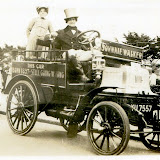Snapshots of cars and their owners
“The "Poop-poop" rang with a brazen shout in their ears, they had a moment's glimpse of an interior of glittering plate-glass and rich morocco, and the magnificent motor-car, immense, breath-snatching, passionate, with its pilot tense and hugging his wheel,
Kenneth Grahame, The Wind in the Willows
In his autobiography Follow my Dust, crime writer Arthur Upfield told a story about the coming of automobiles to the Australian interior. A swagman he knew was walking along a bush road one evening and decided to make camp for the night. The road was relatively flat and in the open so, as he had probably done most of his working life, he unrolled his swag and bedded down. This was, around the 1910s, when the only traffic on bush roads was likely to be slow moving drays or fellow workers either walking or pushing bicycles, and that was in daylight. During the night – you can see this coming, the swagman couldn’t – a truck ran him over.
The story is a reminder of how the automobile completely re-altered our relationship with the places we lived in. One of the photos in the gallery says it well. Sometime around the First World War five people are lying and standing about a car. Painted on its side is the boast; “From Seattle, Washington to Carlyle, Illinois in our Rolls. US. Nice four”. The first sentence makes sense. That was a journey to be proud of, up there with the pioneers who’d travelled the same route the opposite direction in their covered wagons fifty years before. It would have taken a few days and judging by the vehicle’s appearance, several stops to let the radiator cool down and deal with various other malfunctions. Driving from Seattle to Carlyle today might take a little planning but we have cars that reach 240 kph, they have air-conditioning and sound systems, and we have freeways. If pushed, we could do it in a day, comfortably. Where’s the achievement in that?
The way some of the people in the snapshots here pose, one foot on the running board, an elbow on the window frame, clearly suggests the car is their first. They possess it with pride, and why not? Buying a car has opened up their lives. They can now do things that were impossible before, take a girl out or drive to another town for work, or best of all, split that small town and find a real life in the big city. For a down payment of a month’s wages they have been given freedom and power denied to their carless friends.
Owning a car has its disadvantages. You have to keep your eyes on the road and be aware of other vehicles. Driving through the British countryside with its twisting roads and constant villages, you can’t afford to look too closely at the details. On desert highways you have to be aware of what’s happening in the corners of your eyes. Impressions are received by absorption. It’s like listening to music and the two are symbiotic. It can have a dirty carburettor, a leaking manifold or tuned out pistons but if a car doesn’t have a radio it doesn’t work. (The only thing more tiresome than driving in silence is having screaming kids in the back.) Tastes vary but as a rule, Beethoven’s 5th doesn’t really work on an open road in bright sunlight. Bob Dylan does because his entire oeuvre has been about a man moving restlessly from one vicarious experience to the next.
Rock and roll needed two parents for its birth; one was the electric guitar, the other the car. They came together at the very beginning, in Route 66, a name check on the worthwhile towns between Chicago and LA, but before that there was every blues song with road or highway in its title. Bonnie and Clyde is a film about two outlaws but it is also about cars, about crisscrossing the mid-west sticking up banks. Dillinger, Baby Face Nelson and Pretty Boy Floyd also understood the car was their best weapon against the law. The subjects for the FSA photographers – Walker Evans, Dorothea Lange et al – can be divided into two; those who have cars, who must move, and those who don’t and are trapped. Then there was Robert Frank, Robert Adams, Stephen Shore and the others who picked up their cameras, jumped in their cars and showed us what America looked like through a windscreen. The car is the great, supporting character in 20th century American literature. The Grapes of Wrath, Lolita, just about anything by John Updike; Buicks, Dodges, Lincolns and Cadillacs transport the protagonists ever forward into final failure. Whether negotiating a cloverleaf in the pouring rain or pulling into a motel on the Nebraska plains, they all suffer the illusion the car is protecting them.
Jack Kerouac, incidentally, couldn’t drive.
 |
| ON THE ROAD |



No comments:
Post a Comment
Add comments here